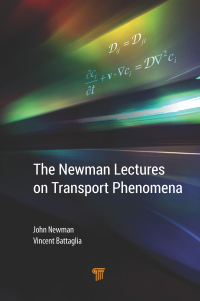Buy The Newman Lectures on Transport Phenomena 1st Edition PDF ebook by author John Newman; Vincent Battaglia – published by Jenny Stanford Publishing in 2021 and save up to 80% compared to the print version of this textbook. With PDF version of this textbook, not only save you money, you can also highlight, add text, underline add post-it notes, bookmarks to pages, instantly search for the major terms or chapter titles, etc.
You can search our site for other versions of the The Newman Lectures on Transport Phenomena 1st Edition PDF ebook. You can also search for others PDF ebooks from publisher Jenny Stanford Publishing, as well as from your favorite authors. We have thousands of online textbooks and course materials (mostly in PDF) that you can download immediately after purchase.
Note: e-textBooks do not come with access codes, CDs/DVDs, workbooks, and other supplemental items.
eBook Details:
Full title: The Newman Lectures on Transport Phenomena 1st Edition
Edition: 1st
Copyright year: 2021
Publisher: Jenny Stanford Publishing
Author: John Newman; Vincent Battaglia
ISBN: 9789814774277, 9781000331356
Format: PDF
Description of The Newman Lectures on Transport Phenomena 1st Edition:
Nanosensors are innovative devices that exploit the unique properties exhibited by matter at the nanoscale. A growing and exciting field, nanosensors have recently spurred considerable research endeavors across the globe, driving a need for the development of new device concepts and engineering nanostructured materials with controlled properties. Nanosensors: Physical, Chemical, and Biological, Second Edition offers a panoramic view of the field and related nanotechnologies with extraordinary clarity and depth. Presenting an interdisciplinary approach, blending physics, chemistry and biology, this new edition is broad in scope and organised into six parts; beginning with the fundamentals before moving onto nanomaterials and nanofabrication technologies in the second part. The third and fourth parts provide a critical appraisal of physical nanosensors, and explore the chemical and biological categories of nanosensors. The fifth part sheds light on the emerging applications of nanosensors in the sectors of society, industry, and defense and details the cutting-edge applications of state-of-the-art nanosensors in environmental science, food technology, medical diagnostics, and biotechnology. The final part addresses self-powering and networking issues of nanosensors, and provides glimpses of future trends. This is an ideal reference for researchers and industry professionals engaged in the frontier areas of material science and semiconductor fabrication as well as graduate students in physics and engineering pursuing electrical engineering and electronics courses with a focus on nanoscience and nanotechnology. Key features: Provides an updated, all-encompassing exploration of contemporary nanosensors and highlights the exclusive nanoscale properties on which nanosensors are designed. Presents an accessible approach with a question-and-answer format to allow an easy grasp of the intricacies involved in the complex working mechanisms of devices. Contains clear, illustrative diagrams enabling the visualization of nanosensor operations, along with worked examples, end of chapter questions, and exhaustive up-to-date bibliographies appended to each chapter.





